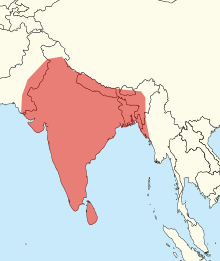Daboia russelii
| Russell's viper | |
|---|---|
 |
|
| A Russell's viper at the Rajiv Gandhi Zoological Park, Pune, India | |
| Scientific classification | |
| Kingdom: | Animalia |
| Phylum: | Chordata |
| Subphylum: | Vertebrata |
| Class: | Reptilia |
| Order: | Squamata |
| Suborder: | Serpentes |
| Family: | Viperidae |
| Subfamily: | Viperinae |
| Genus: |
Daboia Gray, 1842 |
| Species: | D. russelii |
| Binomial name | |
|
Daboia russelii (Shaw & Nodder, 1797) |
|
 |
|
| Daboia russelli distribution | |
| Synonyms | |
|
|
Russell's viper (Daboia russelii) is a species of venomous snake in the family Viperidae. Daboia is a monotypic genus of venomous Old World vipers. The single member species, D. russelii, is found in Asia throughout the Indian subcontinent, much of Southeast Asia, southern China and Taiwan. The species was named in honor of Patrick Russell (1726–1805), a Scottish herpetologist who first described many of India's snakes, and the name of the genus is from the Hindi word meaning "that lies hid", or "the lurker". Apart from being a member of the big four snakes in India, Daboia is also one of the genera responsible for causing the most snakebite incidents and deaths among all venomous snakes on account of many factors, such as their wide distribution, generally aggressive demeanor, and frequent occurrence in highly populated areas.
Daboia russelli is commonly known as Russell's viper and chain viper, among other names.
D. russelii can grow to a maximum total length (body + tail) of 166 cm (5.5 ft) and averages about 120 cm (4 ft) on mainland Asian populations, although island populations may be slightly smaller on average. It is more slenderly built than most other vipers.Ditmars (1937) reported the following dimensions for a "fair-sized adult specimen":
The head is flattened, triangular, and distinct from the neck. The snout is blunt, rounded, and raised. The nostrils are large, each in the middle of a large, single nasal scale. The lower edge of the nasal touches the nasorostral. The supranasal has a strong crescent shape and separates the nasal from the nasorostral anteriorly. The rostral is as broad as it is high.
...
Wikipedia
